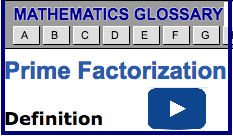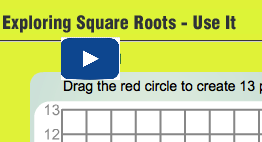Lesson 4: Mixed and Entire Radicals
Module 2: Roots and Powers
Launch
This section checks to see if you have the prerequisite knowledge and skills to be able to complete this lesson successfully.
Are You Ready?
Complete these questions in your course folder (binder). If you are experiencing difficulty, you may want to use the information and the multimedia in the Refresher section to clarify concepts before completing these exercises.
1. List all the prime numbers between 1 and 20.
2. What is the prime factorization of 180?
3. Use prime factorization to determine the square root of 324.
4. Use prime factorization to determine the cube root of 1000.
5. Complete the table by listing the squares of each natural number from 1 to 15. The first three perfect squares have been done as an example.
Once you have completed these exercises to the best of your ability, use the provided answer link to check your work.
If you feel comfortable with the concepts covered in the questions, move forward to Discover. If you experienced difficulties or want more practice, use the resources in Refresher to review these important concepts before continuing through the lesson or contact your teacher.
 Refresher
Refresher
You may find the following useful for reviewing these skills.
In Lesson 1 you created a chart of all the prime numbers between 1 and 100. Retrieve this chart and review the prime numbers in the first two rows.
The “Prime Factorization” applet demonstrates how you can use a factor tree to express a number as a product of primes. Use the applet to get the prime factorization of numbers such as 324 and 1000.
 Read
Read
Go to the textbook and work through the following examples to see how prime factorization is used to identify numbers as perfect squares or perfect cubes. This method also helps you determine the square roots and cube roots of those numbers. As you read, focus on how the prime factors are regrouped into identical groups to find the square and cube roots.
Foundations and Pre-calculus Mathematics 10 (Pearson)
Read “Example 1: Determining the Square Root of a Whole Number” on page 144 and “Example 2: Determining the Cube Root of a Whole Number” on page 145.
Go to “Exploring Square Roots” to explore perfect squares and non-perfect squares. If you are not sure what the difference is, then you should really check this out. You can get the most out of this applet by answering the questions that are posed. The feedback will help you gain a better understanding of the concepts presented.

